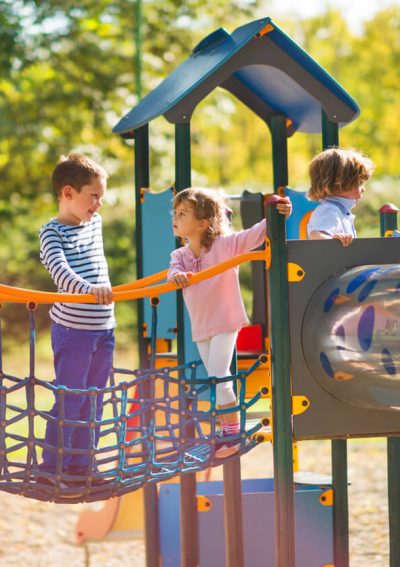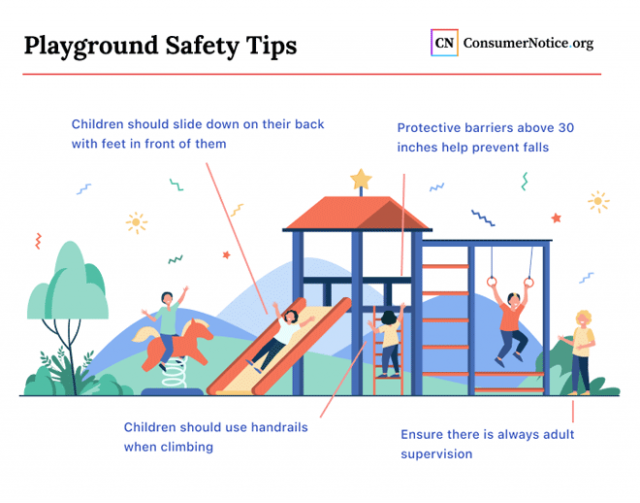Playground Safety
Playgrounds offer vital developmental opportunities for socialization, fun and outdoor exercise. Playground-related injuries are common, though, with more than 200,000 children visiting ERs annually as a result. Coaching kids on safety rules and avoiding hazards can help minimize the risks.

Talking to Your Child About Playground Safety Rules
Routinely coaching children on playground safety rules before they visit the playground can help them understand how to safely use equipment and empower them to behave responsibly. Common playground safety rules include:
- Avoid pushing or roughhousing and take turns.
- Sit properly on swings and seesaws.
- Do not tie any ropes or strings to equipment and avoid wearing clothing with drawstrings that can get caught.
- Avoiding wearing helmets while playing on the equipment.
- Wear sunscreen even if the playground seems shady.
In conjunction with adult supervision and a buddy system for older children, these child safety rules can help prevent injuries and other serious playground accidents like concussions and asphyxiation.
Assure There Will Be Adult Supervision
Playground rules are designed to keep children safe, but even when children do their best to follow them, accidents and injuries can still happen quickly. Asking questions about what safety protocols will be in place when other adults are in charge of our children, such as friends and family, babysitters, daycare and school staff or fellow parents hosting playground playdates, can feel uncomfortable. But it’s important to know what supervision will be available.
Maintaining constant supervision at the playground can be a challenge for anyone and adults are often responsible for more than one child at a time. Some playgrounds may have blind spots as well. Picking a strategic vantage point can help. Using a buddy system with older children can also ease some of the difficulty of supervising multiple children on large playground spaces.
Picking Age-Appropriate Activities
Understanding children’s capabilities is key when choosing which playgrounds to visit and which equipment to use. For example, flat surfaces made of softer materials such as turf or mulch that can mitigate injury in the case of a fall are well suited for children who are still learning to walk.
Playgrounds typically provide distinct play areas for different age groups. Experts recommend that children younger than five years old play in separate areas from older children to avoid accidentally being knocked over, for example, or overwhelmed with older childrens’ more physical play.
Playground equipment is designed with the needs and abilities of specific age groups in mind. Use of playground equipment beyond a child’s physical skill development can result in injury.

Playground Hazards: Surfaces, Equipment and Surroundings
Across the country, playgrounds present a number of common hazards. Preparing children for these dangers and dressing them with these risks in mind can go a long way in preventing playground-related injuries. Common dangers include:
- Improper Ground Surfaces - Roughly 80% of all playground injuries are the result of a fall. Playground equipment should be surrounded in all directions with at least 12 inches of shock-absorbing material such as sand, wood chips, mulch or safety-tested rubber.
- Improperly Spaced Equipment - Playground structures taller than 30 inches should be at least 9 feet apart from each other. Swing sets should have space at least twice their height in front of and behind them.
- Unprotected Elevated Surfaces - Any equipment taller than 30 inches should have barriers to prevent falls.
- Head Entrapment Spaces - Vertical bars or rails should be spaced no more than 3.5 inches apart while horizontal rungs (like those on monkey bars) should be spaced no less than 9 inches apart.
- Sharp Points & Edges - Survey playgrounds for rust, protruding bolts, broken equipment and other sharp points or edges.
- Overly Hot Days - Avoid playground equipment that is hot to the touch and monitor children for signs of dehydration and heat illness.
- Strangulation Dangers - Avoid clothes with drawstrings, necklaces, helmets and any other clothing that could potentially get caught on playground equipment. Additionally, keep leashes, ropes and strings away from children and playground equipment.
Awareness of common playground dangers can help adults know what to look for when supervising children as they play. Individual pieces of playground equipment can present their own specific set of risks as well.
Swing Safety
Of all moving playground equipment, swings are the most common cause of child injuries. In order to stay safe:
- Use swings made with lightweight materials. On public playgrounds, try to use swings made of plastic or rubber when available. As for parents or guardians looking to build or purchase a home playground, avoid buying swings made of heavier materials like metal and wood that can cause injury.
- Ensure children sit on the swing, hold on tightly with both hands and, when finished, stop the swing completely before getting off. Children should never stand or kneel on a swing.
- Avoid walking in front of swing sets that are in use. Advise children to remain a safe distance away on all sides and always wait their turn.
- Be sure children know to never ride a swing with another child at the same time.
Swinging can calm children and help build their sensory skills. Maintaining these simple precautions can help prevent injury.
Seesaw Safety
Seesaws require a degree of cooperation and may be unsuitable for young children. In order to prevent injury:
- Ensure children sit facing one another.
- Teach children to hold on tightly when using the seesaw and keep their feet out from underneath the seat.
- Guide children in finding partners with comparable weight and never add more than one child to a seat.
- Be sure children remain a safe distance away from seesaws that are in use while playing.
More recent designs have measures meant to prevent sudden drops when the weight is removed from one side, however, adults should always be wary of the risks associated with seesaws.
Slide Safety
Careful use of playground slides is important to prevent injury. When using the slide:
- Do not allow children to climb up the surface of the slide. Children should climb the ladder of the slide one step at a time while holding the handrail.
- Children should always slide down in a sitting position with their feet in front of them. Children should not slide down on their stomachs, on their backs or head first.
- Make sure children use the slide one at a time and never in groups.
- Check that the slide is free of obstruction, especially of other children. Once a child reaches the bottom they should clear the way for any children behind them.
Additionally, it is unsafe for adults to go down slides with children on their laps. Slides are typically safe as long as children (and adults) exercise caution.
Climbing Safety
Rock walls, ladders and even monkey bars are common playground equipment and present a specific challenge to children. When using climbing equipment:
- Discuss a plan for a safe way down before they begin climbing and the importance of avoiding jumping from elevated heights.
- Review safety tips such as keeping both hands on the equipment and climbing one at a time.
- Keep off of wet equipment.
Per- and Polyfluoroalkyl Substances (PFAS)
Per- and polyfluoroalkyl substances or PFAS are a group of 5,000 man-made chemicals widely used in a broad range of consumer products. Experts have raised concerns that rubbers made from recycled tires that are used in playgrounds across the United States have been contaminating children with the PFAS.
PFAS do not break down and can accumulate in the human body over time. It is believed that almost all Americans have at least a small amount of these chemicals in their bloodstream. Side effects of exposure to these chemicals can include low infant birth weights, effects on the immune system, thyroid hormone disruption and certain types of cancers.
To best protect children from exposure to these chemicals on playgrounds, adults should do their best to not allow children to eat or drink on them, avoid playing on these surfaces during hot days and have children wash their hands after contact.
Playground Inspection Standards
Adults should examine playgrounds for any potential safety hazards that are present. If any equipment damage or dangerous conditions are found, they should be reported to the school, town/city or private entity in charge of playground upkeep.
Parents should feel comfortable coming together to lobby for safety upgrades as well. Communities can put pressure on playground operators like local governments to implement changes that will make it safer for children to play.
10 Cited Research Articles
Consumernotice.org adheres to the highest ethical standards for content production and references only credible sources of information, including government reports, interviews with experts, highly regarded nonprofit organizations, peer-reviewed journals, court records and academic organizations. You can learn more about our dedication to relevance, accuracy and transparency by reading our editorial policy.
- Centers for Disease Control & Prevention (n.d.). Playground Safety Tips for Parents. Retrieved from: https://www.cdc.gov/headsup/pdfs/parents/headsup_playground_safety_fs-a.pdf
- Consumer Product Safety Commission. (2015, December). Public Playground Safety Handbook. Retrieved from https://www.cpsc.gov/s3fs-public/325.pdf
- Consumer Product Safety Commission. (n.d.). Public Playground Safety Checklist. Retrieved from: https://www.cpsc.gov/safety-education/safety-guides/playgrounds/public-playground-safety-checklist
- Environmental Protection Agency. (n.d.) PFAS Explained. Retrieved from https://www.epa.gov/pfas/basic-information-pfas
- Gilchrist, J. (2018 June). Playground Safety. Retrieved from https://www.healthychildren.org/English/safety-prevention/at-play/Pages/Safety-on-the-Playground.aspx
- Holden, E.. (2019 June). US playgrounds: fears grow over health risks from rubber particles. Retrieved from https://www.theguardian.com/us-news/2019/jun/25/lawmakers-concerned-chemicals-rubber-playgrounds-push-safety-rules
- Kronan, K. M. (2019, September). Playground Safety. Retrieved from: https://kidshealth.org/en/parents/playground.html
- National Program for Playground Safety. (n.d.). Guidelines, Standards and Best Practices. Retrieved from: https://playgroundsafety.org/standards/cpsc
- National Safety Council (n.d.) Staying Safe on Playgrounds. Retrieved from: https://www.nsc.org/home-safety/safety-topics/child-safety/playgrounds
- Safe Kids (n.d.) Playground Safety Tips/. Retrieved from: https://www.safekids.org/tip/playground-safety-tips
Calling this number connects you with a Consumer Notice, LLC representative. We will direct you to one of our trusted legal partners for a free case review.
Consumer Notice, LLC's trusted legal partners support the organization's mission to keep people safe from dangerous drugs and medical devices. For more information, visit our partners page.
844-420-1914
